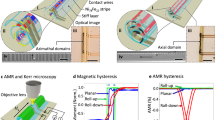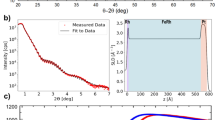Abstract
Thin-film technology is widely implemented in numerous applications1. Although flat substrates are commonly used, we report on the advantages of using curved surfaces as a substrate. The curvature induces a lateral film-thickness variation that allows alteration of the properties of the deposited material2,3. Based on this concept, a variety of implementations in materials science can be expected. As an example, a topographic pattern formed of spherical nanoparticles4,5 is combined with magnetic multilayer film deposition. Here we show that this combination leads to a new class of magnetic material with a unique combination of remarkable properties: The so-formed nanostructures are monodisperse, magnetically isolated, single-domain, and reveal a uniform magnetic anisotropy with an unexpected switching behaviour induced by their spherical shape. Furthermore, changing the deposition angle with respect to the particle ensemble allows tailoring of the orientation of the magnetic anisotropy, which results in tilted nanostructure material.
This is a preview of subscription content, access via your institution
Access options
Subscribe to this journal
Receive 12 print issues and online access
$259.00 per year
only $21.58 per issue
Buy this article
- Purchase on Springer Link
- Instant access to full article PDF
Prices may be subject to local taxes which are calculated during checkout




Similar content being viewed by others
References
Elshabini-Riad, A. & Barlow, F. D. Thin-Film Technology Handbook (McGraw-Hill, New York, 1997).
Chen, Y. J. et al. Periodic magnetic nanostructures on self-assembled surfaces by ion beam bombardment. J. Appl. Phys. 91, 7323–7325 (2002).
Chalastaras, A. et al. GMR multilayers on a new embossed surface. IEEE Trans. Magn. 40, 2257–2259 (2004).
Fischer, U. C. & Zingsheim, H. P. Submicroscopic pattern replication with visible light. J. Vac. Sci. Technol. 19, 881–885 (1981).
Deckman, H. W. & Dunsmuir, J. H. Natural lithography. Appl. Phys. Lett. 41, 377–379 (1982).
Moser, A. et al. Magnetic recording: advancing into the future. J. Phys. D 35, R157–167 (2002).
Weller, D. & Moser, A. Thermal effect limits in ultrahigh-density magnetic recording. IEEE Trans. Magn. 35, 4423–4439 (1999).
Sun, S., Murray, C. B., Weller, D., Folks, L. & Moser, A. Monodisperse FePt nanoparticles and ferromagnetic FePt nanocrystal superlattices. Science 87, 1989–1992 (2000).
Carcia, P. F., Meinhaldt, A. D. & Suna A. Perpendicular magnetic anisotropy in Pd/Co thin film layered structures. Appl. Phys. Lett. 47, 178–180 (1985).
Suzuki, T. Coercivity mechanism in (Co/Pt) and (Co/Pd) multilayers. Scripta Metall. Mater. 33, 1609–1623 (1995).
Hu, G. et al. Magnetic and recording properties of Co/Pd islands on prepatterned substrates. J. Appl. Phys. 95, 7013–7015 (2004).
Landis, S., Rodmacq, B. & Dieny, B. Magnetic properties of Co/Pt multilayers deposited on silicon dot arrays. Phys. Rev. B 62, 12271–12281 (2000).
Bardou, N. et al. Light diffraction effects in the magneto-optical properties of 2D arrays of magnetic dots of Au/Co/Au(111) films with perpendicular magnetic anisotropy. J. Magn. Magn. Mater. 148, 293–294 (1995).
Stoner, E. C. & Wohlfarth, E. P. A mechanism of magnetic hysteresis in heterogeneous alloys. Philos. Trans. R. Soc. Lond. A 240, 599–642 (1948).
Scholz, W. et al. Implementation of a high performance parallel finite element micromagnetics package. J. Magn. Magn. Mater. 272, 693–694 (2004).
Zou, Y. Y., Wang, J. P., Hee, C. H. & Chong, T. C. Tilted media in a perpendicular recording system for high areal density recording. Appl. Phys. Lett. 82, 2473–2475 (2003).
Kai-Zhong, G. & Bertram, H. N. Transition jitter estimates in tilted and conventional perpendicular recording media at 1 Tb/in2. IEEE Trans. Magn. 39, 704–709 (2003).
Acknowledgements
This work was supported by the Deutsche Forschungsgemeinschaft through SFB 513 and the Emmy Noether program.
Author information
Authors and Affiliations
Corresponding author
Ethics declarations
Competing interests
The authors declare no competing financial interests.
Rights and permissions
About this article
Cite this article
Albrecht, M., Hu, G., Guhr, I. et al. Magnetic multilayers on nanospheres. Nature Mater 4, 203–206 (2005). https://doi.org/10.1038/nmat1324
Received:
Accepted:
Published:
Issue Date:
DOI: https://doi.org/10.1038/nmat1324
This article is cited by
-
Electronic materials with nanoscale curved geometries
Nature Electronics (2022)
-
Magnetic skyrmions in curved geometries
Rare Metals (2022)
-
Translatory and rotatory motion of exchange-bias capped Janus particles controlled by dynamic magnetic field landscapes
Scientific Reports (2021)
-
Intrinsic DMI-free skyrmion formation and robust dynamic behaviors in magnetic hemispherical shells
Scientific Reports (2021)
-
Tuning domain wall dynamics by shaping nanowires cross-sections
Scientific Reports (2020)



